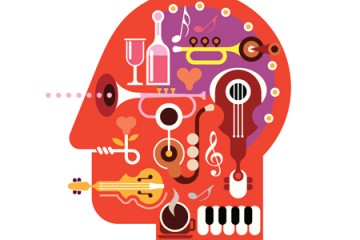Ever hear of "trading fours?"
It's that back-and-forth trade jazz musicians do when they're engaged in a musical "conversation." One musician will play four bars of music, and the other will respond with four bars of her own. This improvised call and response is one of the things that makes jazz music so ... jazzy.
Scientists at Johns Hopkins wondered whether studying the brains of musicians actively engaged in trading fours might shed light on the relationship between music and language. Under the direction of Charles Limb, an associate professor in the Department of Otolaryngology-Head and Neck Surgery at the School of Medicine, researchers placed musicians inside an MRI machine, gave them a special (see: non-magnetic) keyboard, and told them to have at it.
Here's what researchers discovered: The brains of jazz musicians engrossed in spontaneous, improvisational musical conversation showed activation of brain areas traditionally associated with spoken language and syntax, areas that are used to interpret the structure of phrases and sentences. But the musical conversation shut down brain areas linked to semantics—those that process the meaning of spoken language.
The upshot is that the brain regions that process syntax can do more than interpret spoken language, Limb says—they process general communication, whether its through words or music.
"Until now, studies of how the brain processes auditory communication between two individuals have been done only in the context of spoken language," says Limb, who, in addition to being a surgeon, is also an accomplished musician. "But looking at jazz lets us investigate the neurological basis of interactive, musical communication as it occurs outside of spoken language.
"We've shown in this study that there is a fundamental difference between how meaning is processed by the brain for music and language. Specifically, it's syntactic and not semantic processing that is key to this type of musical communication. Meanwhile, conventional notions of semantics may not apply to musical processing by the brain."
Read more from Hopkins MedicinePosted in Health, Arts+Culture, Science+Technology
Tagged music, neuroscience, charles limb, jazz









